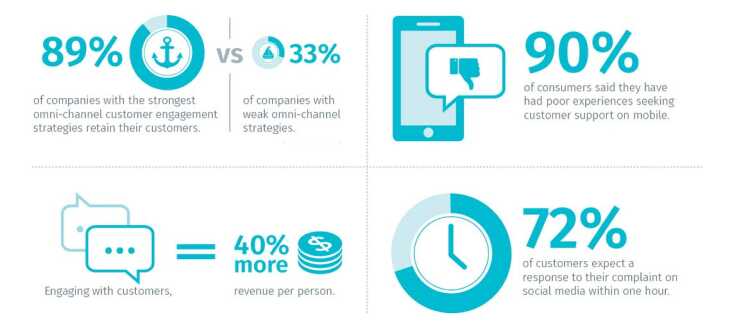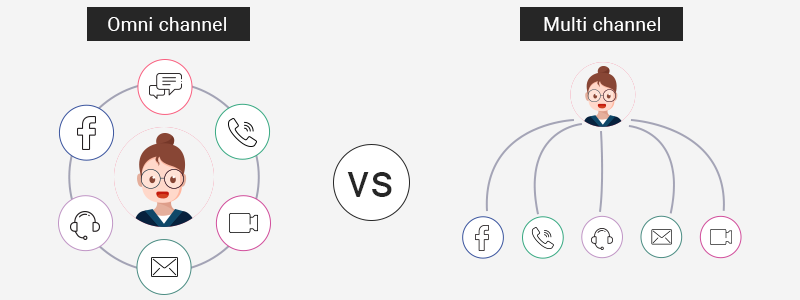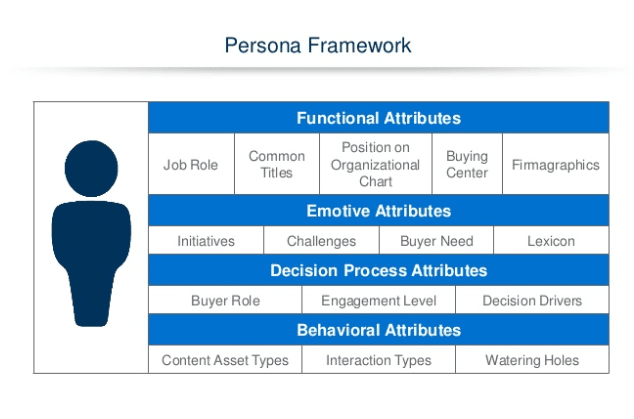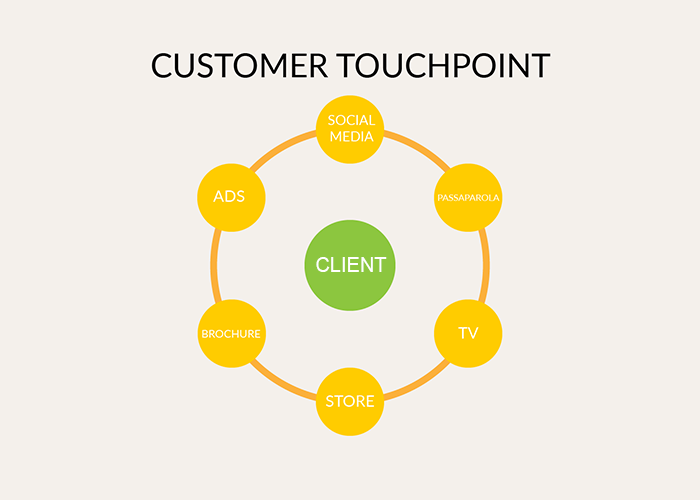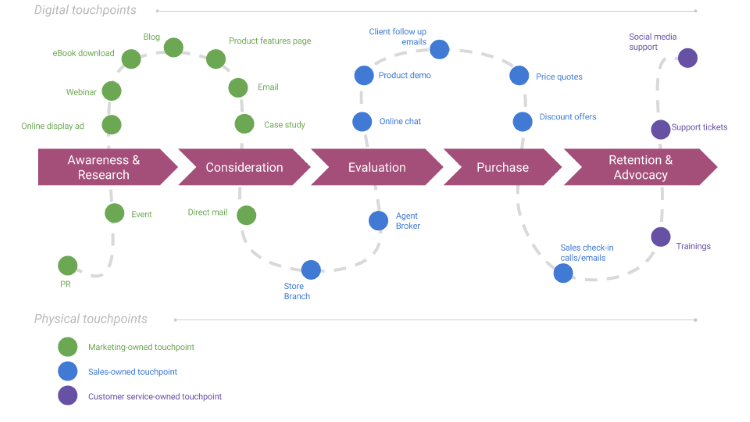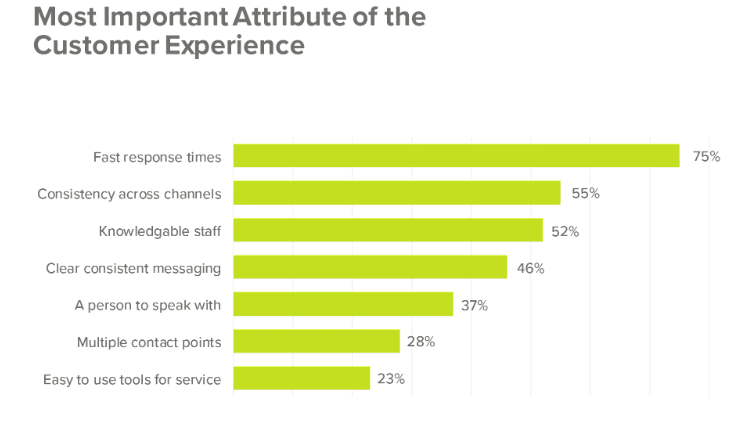Customer expectations are changing swiftly and businesses need to adapt through digital transformation to understand the customers and their journey. Customer experience is now becoming the key differentiating factor in the customers’ decision-making process. The positive or negative experience customers receive across multiple touchpoints is what now defines the brand.
71% of shoppers who use smartphones for research in-store say that it’s become an important part of the experience.
Omnichannel customer experience (CX) is very important to help businesses provide necessary insights into customer interactions and their behavior across their life cycle. The strongest omnichannel customer strategies retain 89% of customers.
So, how would businesses plan their strategy to deliver a superior omni channel consumer experience (CX)?
Prior to diving into the omnichannel customer experience management process, let us understand what it is and why it matters.
What is omnichannel customer experience (CX)?
Omnichannel customer experience (CX) means streamlining all the customer interactions across multiple touchpoints in a unified way to deliver a consistent brand experience. 9 out of 10 consumers want an omnichannel experience with seamless service between communication methods.
The digital omnichannel strategy involves multiple channels approach for sales, customer support, and marketing. It focuses on delivering a cohesive customer experience irrespective of the channel used by customers to reach out to your business.
If seen from the customer’s standpoint, every interaction with your business should be part of a singular experience. It means it should not be siloed or repetitive as it happens with multi channel customer support. Having a seamless journey across all channels, both online and offline is the key to provide a consistent omnichannel experience.
Omnichannel is complex, and many factors contribute to a customer’s evaluative judgment of perceived omnichannel customer experience (OCX). You can check out the peer-reviewed scientific journal article that discusses the concept of OCX and how to measure omnichannel CX.
It illustrates the OCX framework with nine prime focus areas for delivering better CX: social communications (i.e., customer reviews), value (i.e., products and pricing), personalization, customer service, consistency product availability & prices across channels, information safety, delivery, product returns, and loyalty programs.
Omnichannel Customer Experience vs. Omnichannel Marketing
Usually, there is a conflict between omni channel marketing and omnichannel customer experience (CX).
Omni-channel marketing ensures that messaging and branding are consistent among channels. It acknowledges and addresses the customers across their preferred platforms to deliver a smoother buying experience at every stage of their journey. It also includes merging the different channels together (for example, social media, website) for promotional experiences.
Why omnichannel experience (CX) is important for your business?
Great customer experience is the by-product of an effective and well designed omnichannel ecosystem. To achieve it, businesses must understand customer journeys across devices and channels.
Customers who used more channels were more valuable. They spent an average of 4% more in physical stores and 10% more than online single-channel customers.
Source: knexus
Here are the key reasons to move towards an omni channel customer care model.
- Better view on the customer journey: An omnichannel consumer experience strategy gives you a bird’s-eye view of your customer’s journey. It streamlines all the interactions under one platform and provides insights into the right actions for improving your business.
- Higher customer retention: Omnichannel CX strategy empowers customers to connect with the brand through their preferred channels by making a smooth transition in the same interaction. It increases satisfaction and acts as the best customer retention strategy.
- Boost customer lifetime value (CLTV): Omnichannel customers are 30% more valuable to your business over the course of their lifetime. An omni CX approach makes getting in touch with the company simple and intuitive. When a business plan to deliver a consistent response, they also choose your business for a lifetime.
Multi channel vs Omnichannel experience
There are some obvious differences between customer engagement strategies. According to HubSpot, “All omni-channel experiences will use multiple channels, but not all multi-channel experiences are omni-channel.”
The key difference is that omnichannel businesses streamline all customer interactions under a single platform. It means the planning, purchasing, marketing, customer relationship management seamlessly affect all your online and offline channels.
On the other hand, in the multi channel customer care approach, every channel is treated individually and is managed in a unique manner by implementing different strategies. Thus, a multichannel customer care strategy does not focus on creating a consistent shopping experience.
Comparing omnichannel vs multichannel based on the customer experience statistics helps to understand how you can integrate the touchpoints together to provide a consistent experience of a unified journey.
8 Steps for creating a successful omnichannel customer experience journey
In order to build a digital omnichannel customer experience, there are different strategies. By implementing the strategies rightly, you get rid of siloed engagements and deliver a better experience. Businesses who make omnichannel customer service as their focal point are able to boost customer satisfaction and retention significantly.
Here is a quick list of the strategic ways of creating a successful omnichannel customer experience management model.
- Conduct in-depth research in buyer personas
- Identify the preferred customer touchpoints
- Plot your customer journey map
- Use the right tools for omnichannel customer engagement
- Analyze customer feedback
- Use the right balance of automation & human support
- Measure the gaps of fragmented experience
- Develop effective self service options for customers
Let us discuss the different ways comprehensively.
1. Conduct in-depth research in buyer personas
Businesses who lack a solid customer experience (CX) strategy based on deep customer insights complain that they don’t understand their customers. Alternatively, those who develop omni channel CX plans grounded in a survey, demographic, and behavioral data have much better outcomes.
More and more companies exceed revenue and lead goals have documented personas.
Customer personas provide tremendous value to your business by representing different segments that make up your target audience. Using data-driven research is the key to understanding who is your target audience and what motivates them to purchase your products and services.
The most crucial element of a persona’s influence is an improvement to customer experiences. The use of a well-constructed persona results in more effective marketing and sales.
Here is how omnichannel integration helps in creating buyers to deliver a better customer experience:
- Improve value propositions that align with the desired needs of the customers.
- Increase profits by providing customers with what they are looking for.
- Provide a better understanding of buyers, their needs, and how to fix them.
- Accelerate lead conversions by aligning your teams around a customer-centric vision.
2. Identify the preferred customer touchpoints
Always remember the old retail adage: “Customers remember the service a lot longer than they remember the price.” – Lauren Freedman
Identifying your customer touchpoints enables you to have a better understanding of what your customers are feeling at each stage of their buying process with your company and through different mediums and channels.
Source: Megastore
It gives you insights into what customers expect and how you can exceed those expectations in order to create “WOW Moments”. Once you have identified key points where your customers connect with you, you will be better placed to create enhanced experiences for them and devise effective marketing strategies.
How identifying touchpoints help to improve omnichannel consumer experience:
- Understand customers and engage their way – Knowing the preferred touchpoints helps to be actively available across the channels for real time assistance.
- Personalize your interaction – You can personalize your interaction at the identified touchpoints and set excellent customer service experience examples.
3. Plot your customer journey map
A customer journey map is a tool that tells the story of a customer’s experience of interacting with your brand. A typical customer journey map begins with the first exposure that the customer has with your brand or product and follows their engagement through to the point of sale and beyond.
Developing a customer journey strategy begins with mapping the steps the consumer takes on the route to purchase. This mapping process can be complex as customers engage with touchpoints across multiple channels. Increasing the use of mobile and social has also multiplied the number and frequency of contacts during a typical journey.
Applying the customer experience statistics and analytics to the customer journey map can help your business better understand customer interactions and bridge the gap between devices and channels for a unified and satisfying omnichannel consumer experience.
4. Use the right tools for omnichannel customer engagement
It is not possible to deliver seamless experiences across diverse touchpoints without the right technology to enable it. Building the right technology stack to deliver a seamless experience across channels is important to achieving success with omnichannel customer engagement.
From a customer being able to switch between your mobile app and a chat with a bot smoothly, businesses need to use the right digital tools & technology that allows data flow at ease in real-time, to serve customers on their preferred touchpoints.
Key tools that can be used to enhance omnichannel customer experience at different touchpoints.
- Chatbots – Deploy chatbots to engage with customers 24×7 and provide real time answers for simple queries.
- Live chat – Provide real time assistance to the sales and support related queries with live chat and improve customer satisfaction.
- Live engagement tools – With co-browsing, collaborate with your customers by sharing their browsers to guide them through a complex form fill-up. With a video based call center, you can identify issues faster and deliver personalized solutions.
By using digital tools and customer engagement strategies, provide real-time response, and effective solutions. You can strengthen your relationship with existing customers and increase brand loyalty.
5. Analyze customer feedback
Customer feedback is a blessing in disguise for businesses as it brings in golden opportunities that can help you to improve the omnichannel customer journey. Delivering superior service means delivering real time support by being where your customers are and giving them an easy way to share feedback.
Omni channel customer service approach allows brands to engage with customers through every channel and capture feedback at every customer touchpoint. The different ways to ask for customer feedback are website, social media, emails, in-app, reviews, etc.
Here is how analyzing customer feedback can improve the omni channel CX.
- Use customer feedback to develop an in-depth understanding of your customers to serve them better.
- Implement a system to help you collect feedback, analyze it, and act on it regularly
- Reduce friction and solve your customers’ specific problems and challenges
6. Use the right balance of automation & human support
One vital aspect of omnichannel customer experience management is the right balance of automation, and human understanding: Customers expect brands to understand them with intelligent technology along with authentic and empathetic human experiences.
Choosing the right approach needs a deep understanding of using live chat vs chatbot by learning the pros and cons of both channels. The balanced support approach manages the resources on priority tasks. You can use chatbots at the primary stage and put human support for complex conversations.
Designing both into the overall customer service experience design helps maintain the appropriate balance, which can become a real differentiator for the brand. Knowing when a conversation needs to move from a bot to a human, for example, knowing when to appease an angry customer with an apology versus an offer, and so on. is how the balance manifests.
7. Measure the gaps of fragmented experience
Identifying the gaps in fragmented experiences is a vital part of improving omnichannel customer experience. Delivering better CX is always work in progress and as customer habits keep evolving, so should be the experience brands aim to deliver.
Earlier, the concept of providing customer service over social media didn’t exist. And today, it is one of the major platforms to provide immediate assistance to customers while also scoring brownie points in full view of the entire customer community.
Measuring the gaps provides you insights into what actually your customers are looking for and takes the right steps of improvement to deliver a better omnichannel customer experience.
Pro tip: Keep an eye out for any data gaps between various channels, as that may force customers to refer to different sources or channels for one purpose, making them lose time, causing inconvenience, and ultimately spoiling their overall experience.
8. Develop effective self-service options for customers
Businesses are recognizing the benefits of self-service portals for improving the overall brand experience. As customers want instant answers to their questions or problems. In fact, response time is the most important attribute of the customer experience.
Self-service portals provide customers with instant access to information and save valuable time and business resources. 67% of customers prefer to use self-service options instead of speaking with a company representative.
You can create a content hub in the form of tutorials, manuals, videos to help customers to solve their problems on their own. Here are the key benefits of self service portals:
- Use personalized information – The self-service portal can maintain a record of the products or services purchased and display what is relevant to them. You can identify customer issues and take adequate steps to address them.
- More positive recommendations – Such portals help to strengthen brand reputation by creating positive client interactions.
- Educate customers – You can expand your customers’ knowledge & skills they require for solving other similar issues in the future.
Examples of Omni channel Marketing
At its core, omnichannel customer experience (CX) refers to brands that have the approach to deliver an integrated shopping experience. The customer has a seamless experience of an easy transition from shopping online on a desktop or mobile device, to the phone, or a brick-and-mortar store. Omni integration fosters a greater sense of familiarity with the brand, which impacts positive brand image and retention rates.
Here are two examples of omnichannel integration and innovation in the way to deliver a great consumer experience.
#1. Example of omni channel retail – Crate & Barrel
Crate & Barrel understood the fact that usually consumers switch through several different devices prior to completing purchases. They moved to omnichannel settings to capitalize on the customer behavior of the toggling to devices.
Whenever a customer is logged into their account, the app saves their shopping cart and browsing data so they can access this information across multiple devices. It helped customers to take up where they left off in the shopping process which greatly reduces the shopping cart abandonment rate, and Crate & Barrel has reaped great returns and delivered a great omni channel shopping experience.
Achievements
- Crate & Barrel’s implementation of an omnichannel customer experience strategy resulted in a 10% revenue increase from the newly improved mobile and web stores.
- Going further in the path of innovation, they released their 3D Room Designer feature, allowing consumers to virtually place an item into their home before purchasing.
#2. Omni channel retail example – Oasis fashion
Oasis, a highly acclaimed UK based fashion retail brand operates online as well as physical stores globally. It was really impressive that they integrated both online and offline stores together to provide an all-round omnichannel retail shopping experience to its customers.
The store realized the core part of moving to an omnichannel customer care approach was to:
- Figure out all the online and offline places your customers hang out.
- Create touchpoints in the identified places and make the touchpoints shoppable.
And their touchpoints were not just the stand-alone sales or support channels. They integrate with each other to bring a more unified experience.
Key learnings:
- Make things as simple as possible for your customers. Oasis separated out their personal shopping section of their site into occasions to attract their customers to explore the section more.
- Use social media to encourage your customers. Oasis encouraged exploration of their site through their social channels. They used specific product item codes to entice users to explore more about each product.
Get started with your omnichannel customer experience or better
Many companies, whether eCommerce or retail, often fail across digital channels because they are not completely aware of the exact needs and preferences of their customers across omnichannel journeys. And today’s customers have an unprecedented number of ways to engage with companies, from traditional channels to an ever-growing array of digital modes.
Hence, businesses need to get started by investing in digital channels along with the existing traditional channels to deliver an omnichannel customer experience. The thinking is that as customers become more technologically savvy, they favor digital channels, significantly reducing the need for live agents and thus saving significant costs.
In order to design an omnichannel customer experience, companies should follow a sequential process comprising of four essential components:
- Outlining the principles based on an overarching omnichannel strategy.
- Structuring service journeys, ensuring that the end-to-end digital contact journeys address identified customer needs.
- Identifying foundational enablers to support the journeys, featuring multi-skilled agents to engage with customers in real time.
- Defining the architecture with advanced technology to support a seamless omnichannel customer experience.
An omnichannel transformation is the only way for retail or eCommerce businesses to address the rising complexity, provide an excellent customer experience, and manage operations costs.
Omnichannel customer experience is a differentiating factor
Omnichannel CX makes communication smooth across multiple channels to help customers improve their experience. Customers are viewed as the ones in power, telling businesses what they need rather than being told by businesses they need for their product or service. Great customer experience management focuses on personalizing every customer experience and keeping customer retention high.
When customer satisfaction improves, word spreads quickly between friends, family, and social media, encouraging other people who never knew of these possibilities to reach out to your business.

